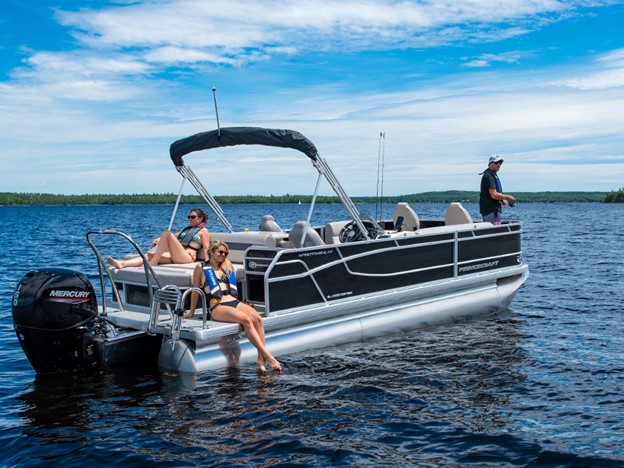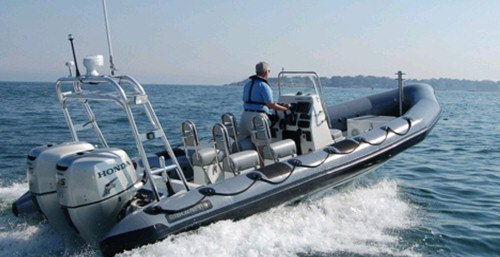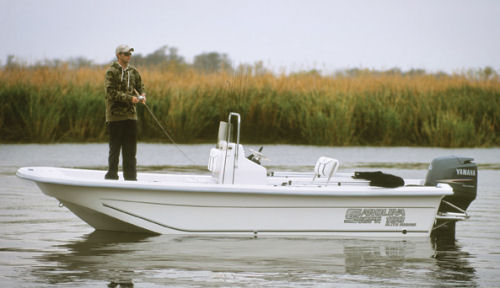Engine Buying Tips: How to Select the Right Horsepower for an Outboard Boat, Part 1
The engine is the most important and most costly component in your boat. To a large extent, as does the engine, so does your boating experience. Making a mistake on your propulsion package — either underpowering or overpowering your boat — can be costly.

Do you want to go 75 mph or 7 knots? The speed of your boat is one of its most important attributes. Make a mistake and it will cost you dearly.
Speed and the Boat’s Hull
The speed you need will be an important factor in engine selection. If you wish to travel at Mach1, you will find the purchase price of your engine and boat will be high. The hull which houses those expensive turbocharged or supercharged hotrods has to be incredibly strong because the faster your boat hits the water, the harder it gets. Just think of your car running over a series of speed bumps placed every 30' across the road, then imagine what would happen to your car if you traveled over a mile or two of those bumps at 70 mph!
The more high-technology materials, such as Kevlar and carbon fiber, that are used in the hull, and the more stringers and bulkheads that need to be put into the boat, to say nothing of a thicker, cored laminate, the more the hull will cost. If you ever wondered why high-performance boats are so expensive with so little inside them, now you know.
With these things in mind, let us now look at the major types of small boats and see what engines might be best for your application —
1. RIBs and Inflatables
Inflatables and RIBs are not as easy to power as one might think. The days of the little kickers are over except for the compact inflatables that one can roll up and store in a boat’s lazarette or trunk of a car. Usually, the weight of the engine and how much the owner can lug will be the determining factor on max horsepower, usually, 9.9 to 25-hp for small inflatables.
RIBs take more horsepower because they are far heavier than inflatable boats. All boats are weight-sensitive, and RIBs are no exception. For that reason, owners should get as light an engine as possible that has a lot of low-end torque. That is why 2-stroke outboards are often favored by many RIB owners.

Many RIBs actually draw more water than a similar-sized all-glass or aluminum boat because so much of the beam is the inflatable tube itself, which is not submerged as much as is the fiberglass hull it is attached to. This means more horsepower is needed until they are on plane, and then they fly due to reduced wetted surface.
The key with RIBs is to get the boat on plane without having to put everyone in the bow to trim the boat while it is building up speed. Depending on the size of the RIB, we would recommend from 40-hp to 50-hp as a minimum on the small end, say 12’ to 14’. Here, we recommend 2-stroke engines. The really big RIBs can have two or three big outboards on their transom and they need them in order to go fast and carry a load.
2. Aluminum Outboard-Powered Boats
These boats can be powered by anything from 50-hp to 300-hp, depending on the size of the boat and the mission. Typically, these boats are used for fishing, so the size of the engine depends on the load to be carried and how fast the owner wants to go and how far. We recommend that boat buyers calculate the anticipated total weight of the boat with passengers, fuel and gear, then decide what best cruise speed they want to attain if they plan on fairly long runs.

When equipped with 250-hp or 300-hp outboards, these types of aluminum fishing boats can typically have a WOT of 55 mph to 60 mph, or a bit more with two people aboard. But you don’t have to put engines that large and expensive on a 16’ to 24’ aluminum fishing boat. Boats in this size range with 115-hp to 150-hp engines typically have their best planing fuel economy in the 23-mph to 28-mph range with these size engines and have a WOT in the high 30s or mid-40 mph range.
Before moving up into the large outboard engines, make sure that you really need that much horsepower. Some 90-hp engines in 18’ aluminum boats with two people aboard will perform almost as well at cruise and have a WOT in the low 40s.
16' aluminum boats are popular and a 60-hp engine will typically propel them from 25 mph to 30 mph top speed, depending on load.
3. Bass Boats
These very specialized boats are designed for one purpose only -- bass fishing on relatively small and calm bodies of freshwater. For many anglers, their bass boat is a thing of rare beauty and they treat their boats much like collectors of antique cars pamper their classic (and expensive) automobiles. While virtually all builders of bass boats design them for tournament fishing, most people who buy them actually do not enter tournaments and instead use them for low-key recreation fishing enjoyment.
Having identified at least three categories of bass boat owner (tournament anglers, casual fishermen, and bass-boat aficionados), it is not surprising that the power needed for all three purposes would be quite different. Boat-builders and engine makers spend millions of dollars each year promoting bass boats powered by very large outboard engines.

Anglers engaged in tournament fishing are going to want the biggest engine on the transom that the boat is rated for, in most cases, and that means from 225-hp to 300-hp. But more casual anglers, particularly ones fishing on smallish lakes, have no need for such prodigious amounts of horsepower.
For example, a 2,800-lb. fiberglass bass boat powered by a 150-hp outboard will have a WOT speed in the 50-mph range, and will have its most economical cruise in the mid-30s with two people aboard. Who needs to go faster than that? If your lake is small, perhaps an even lower horsepower engine would serve the purpose. In that case, your major consideration would be finding a like-minded angler come re-sale time.
Traditionally, bass boats have been the domain of 2-stroke outboard engines. They are light-weight and have a lot of low-end torque which makes for fast hole shots.
4. Bay Boats and Skiffs
Like bass boats, bay boats are designed for a very specific application – saltwater fishing in skinny, protected conditions. Bay boats go where the water is flat, so like the bass boat, they don’t need much freeboard. And, like the bass boat, their bottoms are relatively flat, like that of a skiff, and if powered by large outboards they can go lickity-split.
Builders and engine makers often display these boats — which are typically 16’ to 24’ long — with 250-hp to 300-hp engines. You must ask yourself, how fast and how far do you need to go on an average fishing trip? The answer may be 50 miles or more, in which case you may well want the extra juice so that you don’t spend all of your time traveling to and from the fishing spot.

On the other hand, if you will be fishing just a few miles from home or the launch ramp, why do you need all of that horsepower? Perhaps 100-hp or 150-hp is all you need. Again, the best cruise speeds and WOT speeds of the boat should be your guide, given the body of water, you’ll be ranging over.
Unlike bass boat owners, bay boat owners do not care so much about hole shot speed so they are open to both 2-stroke and 4-stroke engines, so long as they are competitive in fuel economy. But remember, 4-stroke engines have weak low-rpm torque. They will not be as quick to plane as will be a 2-stroke engine.
We'll look at outboards for other types of boats in Part 2, coming soon.